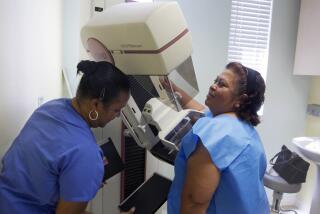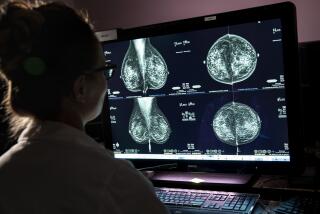A Realistic View of Breast Cancer
- Share via
American women fear breast cancer. But surveys show they don’t always do everything they can to minimize their risk of dying from it. This book by medical geneticist Patricia Kelly is an outstanding attempt to alter these conflicting forces.
Kelly provides one of the most understandable and comprehensive explanations I’ve seen on why most women need not be afraid of the disease. She does this while encouraging prevention strategies such as regular mammograms after age 40 and breast self-exams. As she notes: “Most women are uncertain about what their breast cancer risk actually is, which parts of the constantly changing information they can trust, and what to do about an increased risk.”
The bulk of this book explains why most women will never have breast cancer and should go a long way toward alleviating unfounded fears. In particular, it puts into context the statistics and “facts” on breast cancer that are pervasive in the media and even in some doctors’ offices. For example, in reviewing the concept that one in nine women will develop breast cancer, Kelly shows that a woman’s risk of the disease is just 2% to age 50, 6% from 50 to 70, and 3% from 70 to 85. She also provides valuable insight on the increased breast cancer risk of women with a mother or sister with breast cancer. As Kelly patiently explains, most of these women will never develop breast cancer, either. Their risk to age 69 is 16%.
The beauty of this book lies in the author’s explanations on how statistics are used and sometimes misused. For instance, a woman with a mother or sister with breast cancer often hears that she has a two to three times higher risk of the disease then do women with no family history--an alarming concept. But, as mentioned above, that risk is still only 16% to age 69, which is a much more reassuring way to think about actual risk while acknowledging the increased odds. In another example, Kelly takes note of a highly publicized study showing that the drug tamoxifen reduced breast cancer in high-risk women by 49%. But in terms of actual risk, tamoxifen prevented only 1.8 cases of cancer per 100 high-risk women over a period of six years. Put this way, high-risk women may weigh more carefully whether to take the drug.
Perhaps the greatest contribution of “Assessing Your True Risk of Breast Cancer” is the material on two controversial topics: hormone replacement therapy and its connection to breast cancer, and the meaning of a diagnosis of “ductal carcinoma in situ.”
Kelly includes an exhaustive review of the hormone therapy studies to date and concludes that the risk of using hormones is slight. Although some research has cited a 30% to 50% increase in breast cancer risk among hormone users, there are actually only 0.6 more cases of the disease per 100 women ages 50 to 70. She also presents a less alarming view of a study published earlier this year that showed a 12% increased risk of breast cancer per year among thin women taking estrogen and progesterone. Because the risk is 12% greater than an already very small risk, Kelly explains, only one additional case of breast cancer would be detected among 2,000 women using the combination therapy. She concludes: So many studies have looked at the association between HRT and breast cancer that, “it will be very difficult for future studies to overturn the current body of evidence” that the risk is slight.
The chapter on ductal carcinoma in situ, the breast condition with the greatest rate of increase in recent years due to improved mammography, is also reassuring. Kelly explains that the condition is not actual cancer, but a pattern of abnormal cell growth, and that DCIS lacks the biological capacity to spread to other parts of the body.
Other risk factors are discussed as well, with Kelly putting into context commonly cited factors such as use of oral contraceptives, age at menstruation, whether or not a woman has children and, if so, her age at the birth of her first child.
She also explores the issue of whether a woman should begin regular mammograms at age 40 or age 50.
With all this information, plus a discussion of prevention strategies and information on what to do if you are diagnosed with breast cancer, this is the book to buy if you want to be informed about breast cancer without being frightened.
*
Breast Cancer Reference
* A new book makes a levelheaded assessment of the risks of breast cancer. S2






